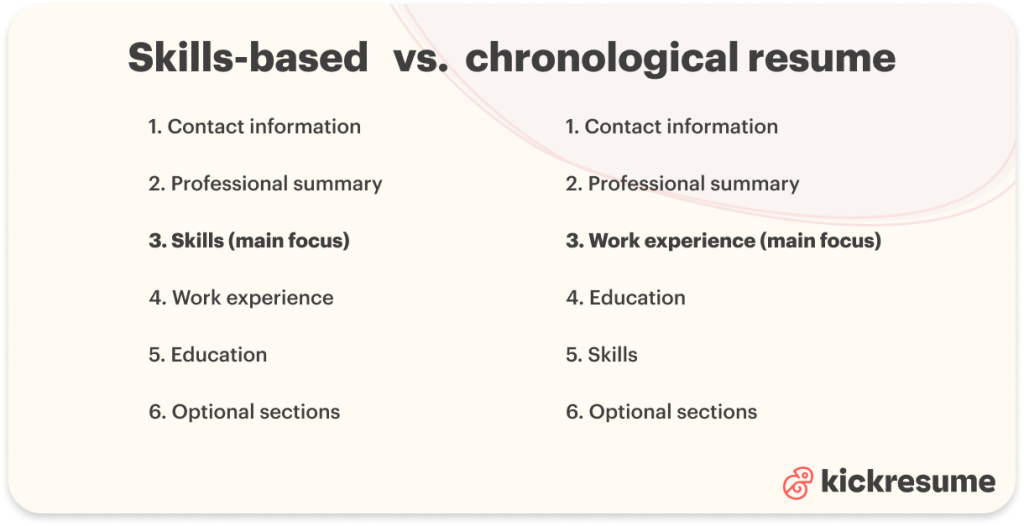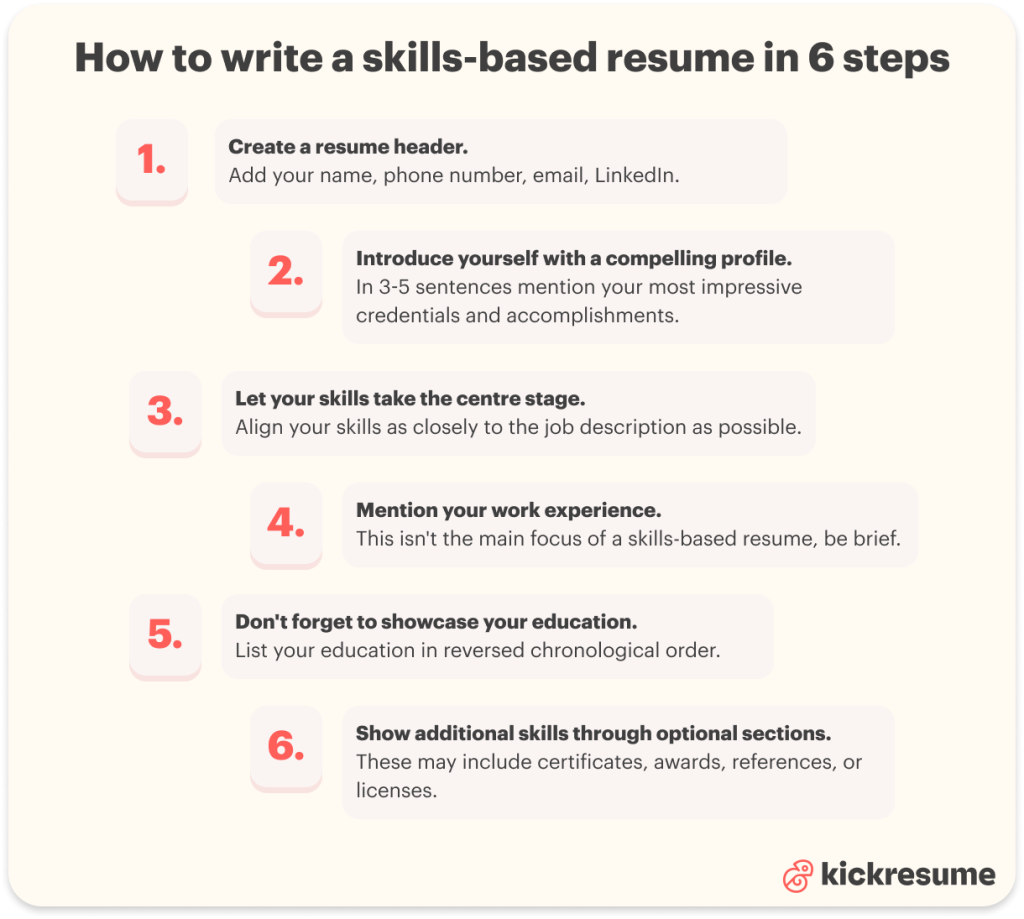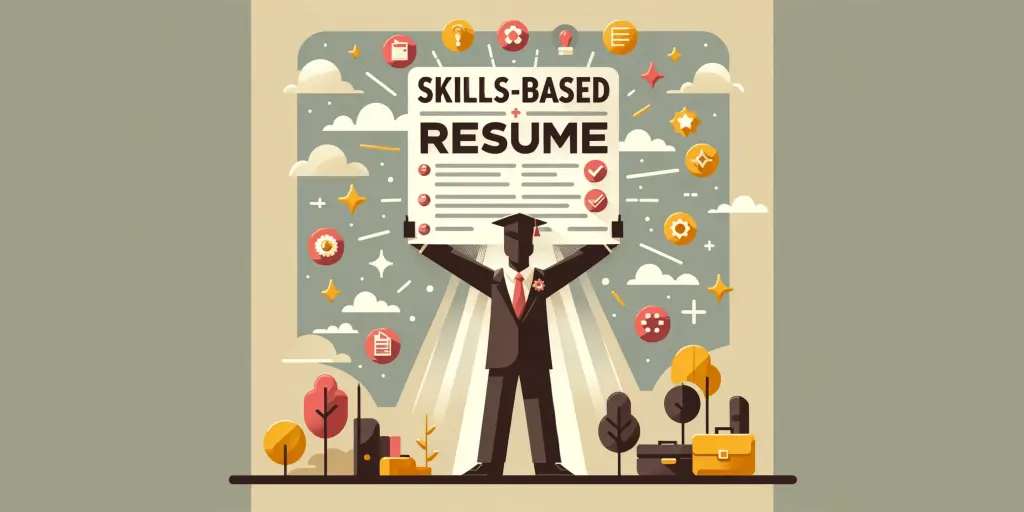Unlike the conventional chronological resume, skills-based resume prioritizes your skills and abilities over your work history.
This way, you can turn your expertise into a compelling narrative, setting you apart from the competition.
Although less common, this style of resume isn't just a fleeting trend. In fact, the preference for skills-based resumes has been steadily growing among employers and employees alike, according to a recent report.
Wondering what makes this approach a game-changer and how you can benefit from it?
Welcome to our comprehensive guide where you'll find:
- What is a skills-based resume;
- Who is it for;
- How to write a skills-based resume;
- A skills-based resume template.
What is a skills-based resume?
A skills-based resume is a type of resume format, which allows you to put forth your best qualities relevant to the job you're interested in.
This is achieved by making the “skills” section the main focus of your resume, while the “work experience” and “education” sections take the back seat.
Why is the emphasis on skills so important?
Even if job titles stay the same, the tasks, projects, and things you can learn from them can vary a lot. In the professional world, people in the same job position don't always have the exact same skills. Each person's unique set of skills is shaped by their individual experiences, tasks, and personal growth.
Who is a skills-based resume for?
Choosing the right resume format is all about pointing the recruiters' attention to your strengths and away from your weaknesses. And choosing the right strategy (i.e. resume format) depends on your situation.
A skills-based resume may be an excellent choice in case you:
- Want to change careers. You decided to step into uncharted territory and switch careers or industries.
- Are a recent graduate. Finding a job right after graduation is notoriously difficult, mainly because you don't have any professional experience.
- Have little to no relevant experience. Your interest in a specific job may come from volunteering or pursuit of your passion outside of work.
- Have a gap on in resume. You may have chosen to take a break from your career for any personal or health-related reason.
- Are a job hopper. You've held a great deal of different jobs, but not for a very long time.
All of these scenarios have one thing in common: lack of continuous, long-term work experience in a specialized position.
Which is why you want to make the recruiters notice your skills first.

Skills-based resume vs. chronological resume: What's the difference?
The key differences between a skills-based resume and its more traditional counterpart (chronological resume) lie in their focus and structure.
1. Focus
- A skills-based resume focuses on your, well, skills. It answers the question “What can you do?” rather than “Show me where have you worked.”
- A chronological resume, on the other hand, focuses on presenting work experience in reverse chronological order. Chronological resume is a great fit for seasoned professionals with a stable work history. If you've been on a consistent career path, with each job building on the last, this is the format for you.
2. Structure
The difference in their focus also reflects in their structures. Both skills-based resume and chronological resume dedicate the largest portion of their layout to showcase relevant skills and work experience respectively.
Skills-based resume structure
- Contact information. Include your name, phone number, email, LinkedIn profile, and relevant social media accounts.
- Professional summary. A short section which briefly states your career objectives and most relevant skills.
- Skills (main focus). This is the most extensive and detailed section. We'll take a closer look at what to include in this section later in this article.
- Work experience. If you have any, include 2-3 most recent ones (there probably won't be space for more).
- Education. You should list them in chronological reverse.
- Optional sections. May include volunteering, certificates, licences or awards.
Chronological resume structure
- Contact information. Include your name, phone number, email, LinkedIn profile, and relevant social media accounts.
- Professional summary. Briefly state most notable experience and qualifications.
- Work experience (main focus). This is the most extensive and detailed part. Presents work experience in reverse chronological order. Details daily tasks and accomplishments connected to each of them in bullet points.
- Education. Also chronologically reversed.
- Skills. Eg. language competence or computer skills. Show the level of skills without much detail - most typically through infographics.
- Optional sections. May include volunteering, licences, certificates or awards.
How to write a skills-based resume: step-by-step
By now, we've identified the main attributes of a skills-based resume and established who would benefit most from using it.
Let's look at how to create an effective and well-organized skills based resume in 8 steps.
- Start with research!
Go back to your job posting. Try to identify repeating keywords and phrases describing what the ideal candidate for that particular position should be like.
- Custom tailor your resume to the specific job.
Each resume you send out has to be especially tailored to a specific job description. If you're struggling to identify what skills you need for a particular job, feel free to read job postings for the same position at different companies.
- Create a clear resume header.
At the top of your resume, include a contact/personal information section which has your name, phone number, email, LinkedIn.
- Introduce yourself with a compelling profile/summary.
A 3-5 sentences long resume summary should highlight your key achievements and skills. It's an introduction to who you are professionally. Your summary must be concise, to the point, and eye-catching at the same time.
- Let your skills take the centre stage.
The skills section should be the most prominent one, both visually and content-wise. You can organize your skills into categories to highlight different aspects of your abilities. Tailor them as closely to the job description as possible.
- Mention your work experience.
You can be bries as this is not the main focus of a skills-based resume. Arrange your work experience entries in reverse chronological order, stating: your employer's name, dates of employment, and the role you held.
- Don't forget to showcase your education.
Make a note of: the name of the institution, what did you study, dates of study, and your GPA (if it's something you can be proud of).
- Show additional skills through optional sections.
For example, include: certificates, awards, references, or licences pertaining to the job you wish to pursue.
In the following chapters, we look at each step in more detail and give you helpful tips and examples.

Step 1: Start with research!
Before you start writing, you must do a bit of research. Go back to your job posting. Read it again. Try to identify keywords and phrases describing what the ideal candidate for that particular position should be like.
Usually, you can find these under the heading “requirements” but it's not always that simple. The keywords you're looking for can be sometimes embedded in the text.
If you want to get invited to a job interview, you must show the recruiters that you have what they're looking for. Make sure your resume always caters to the specific needs of each job posting you respond to.
Step 2: Don't forget to always custom tailor your resume!
Each and every resume you send out has to be especially tailored to a specific job description. This is the golden rule.
If you're struggling to identify what skills you need for a particular job, feel free to read job postings for the same position at different companies. The competences should be somewhat similar across the board. Bonus points, if you also research the company and their culture.
Step 3: Create a clear resume header
Regardless of the format, every resume needs a header. Usually, it sits in the top-part of your resume. Make sure the header is clearly visually separated from the rest of the text.
- Start with your full name in a slightly larger font, making it the focal point.
- Include your contact information, such as phone number and professional email, ensuring they're easily accessible. If you're applying for a job abroad, don't forget to add correct country code before your phone number ( e.g. +421 *** *** ***).
- Add your LinkedIn profile, personal website, or relevant social media accounts if relevant. In case you have all of the mentioned, pick only a few that will feature in your header.
- Consider adding a photo. Including a photo in your resume is a topic of debate and it usually depends on location and industry.
Step 4: Introduce yourself with a compelling profile/summary
Write a concise summary at the beginning of your resume, highlighting your key achievements and skills. Treat it as an introduction to who you are professionally.
A resume summary should:
- Be about 3-5 sentences long
- Connect your skills to real-world accomplishments to add context
- Mention your most impressive credentials and accomplishments
It should also be specific, to the point, and eye-catching at the same time.
Consider the following resume summary example:
Resume summary example
If you're fresh out of school, your resume summary can look like this:
Student / recent graduate resume summary example
Step 5: Let your skills take the centre stage
This section is the most prominent one, both visually and content-wise.
You can organize your skills into clusters or categories to highlight different aspects of your abilities. Align them as closely to the job description as possible.
- Use sub-headings. Ideally, these would be directly connected to the key words found in the job posting. For example, if the advertisement calls for a candidate with time management, leadership, and communication skills, these should be your sub-headings.
- Get into specifics. Underneath each subheading, put 3-4 bullet points where you will expand more on each skill. Describe your background with that skill and, if possible, also your successes.
- Use quantifiers (if possible). The truth is, job descriptions tend to be quite vague. Anyone can write that they have good communication skills, and perfect time management. But what exactly do these phrases mean? Using quantifiable metrics will show the impact of your contributions more effectively.
Take a look at these examples. Each deals with “leadership skills'' but from a different standpoint. Let's imagine that the first example was written by a person (A) leading a marketing campaign. Their skills description would look like this:
Leadership skills example A
The second person (B) has spent the last two years working in retail, making their way up to the position of a store manager. Their “leadership skills” could be specified as follows:
Leadership skills example B
What skills can you include in your skills-based resume?
In your skills based resume, you should include both hard and soft skills.
- Soft skills. They're also called transferrable skills and are characterized as interpersonal, non-technical know-how. Transferable skills are skills you've acquired through experience in one job position; but which can also be applicable in different professional contexts. These are gained over time and cannot be taught using a textbook. Communication, time management, and leadership are all examples of transferable skills.
- Hard skills. These are specific, technical proficiencies that can be learned, measured, and quantified.
1. Soft skills
These are especially useful to career changers, recent graduates, or people with little work experience – people who would benefit from a skills-based resume.
Soft skills are more about your personal qualities and how you navigate the social aspects of your job.
Soft skills act as a universal toolkit, highlighting your flexibility and professionalism. Spotting and highlighting these skills on your resume is key.
If you aren't sure which soft skills to incorporate into your resume, take a look at top soft skills employers can't resist. You'll certainly find a few you are good at.
2. Hard skills
Another kind of skills you can draw from are hard skills. These are specific, technical proficiencies that can be measured and quantified.
Examples of hard skills include technical skills like:
- coding
- data analysis
- using specific software and tools (Microsoft tools, Photoshop, etc.)
- language skills
Hard skills are often job-specific and can be precisely defined and evaluated.
Step 6: Mention your work experience
As this is not the main focus of a skills-based resume, let's be brief.
Arrange your work experience entries in reverse chronological order, stating:
- your employer's name,
- dates of employment,
- and the role you held.
Don't go into detail on your competences and responsibilities – this isn't the space for this. Any relevant skills should be addressed in the “skills section”.
Remember that internships also count as work experience.
Your work experience entry can look something like this:
"XYZ Events Company | Party Organizer
January 2021-November 2023"
Step 7: Don't forget to showcase your education
Again, list your education entries in reverse chronological order. Make a note of:
- name of the institution,
- what did you study,
- dates of study,
- your GPA (if it's something you can be proud of ;) )
Here is an example of what your education entries can look like:
“St. Andrew's University, Scotland
Bachelor of Science in Communication Technologies
GPA 3.9 | 2016-2020“
Step 8: Show additional skills through optional sections
Do you feel that there's still more to share? There's a way to sneak them in.
If you have some space left, you can dedicate it to anything that can boost your value and desirability. You can, for example, include:
- volunteering
- certificates
- awards
- references
- licences relevant to the job you wish to pursue.
Be ready to provide proof of your awards, certificates, or licences when asked to.
Skills-based resume template
After theory comes practice. We'll now walk through a specific skills-based resume example and analyse its key features.
Here's a skills based resume template:
What's so good about this resume?
- The header is the very first thing that grabs your attention. Barbara made sure we won't overlook her name.
- Her inclusion of both her phone number and email address enables recruiters to access her contact details easily.
- In her summary/profile, you'll notice her usage of keywords, such as “effective team player,” “communication,” or “time management.” She directly states what value she'd bring to the company.
- Barbara divided her skills section into several categories, each with its own sub-heading.
- She decided to list her hard skills (languages and computer skills), as well as her soft, or transferable, skills (communication, multitasking, teamwork, critical thinking, etc.).
- Notice that instead of bullet points, she decided to indicate the level of her skills via infographics. While it gives the resume a more sophisticated and sleek look, recruiters may find this less persuasive.
- Her education entries are in reverse chronological order.
- Since Barbara is yet to finish her studies, she lacks any practical work experience. Instead, she chose to highlight her volunteering experience.
- Finally, she included a section “certificates” where she mentions her driver's licence. At first, this might seem redundant, but this is a common requirement in many professions.
Everyone knows that formatting resumes is a particularly tedious and annoying ordeal. Why waste time battling with divisions and margins – with these resume templates you can have a skills-based resume in seconds. Save yourself time and sanity. Be like Barbara.
Key takeaways: Skills based resume
A skills-based resume prioritizes skills over work history, offering a unique approach to showcasing your abilities, qualifications, and competences.
It's ideal for career changers, recent graduates, those with limited experience, gaps in employment, or varied job histories – for anyone who doesn't have a continuous, long-term work experience history.
You can include any relevant soft (transferrable) or hard skills that will convince the recruiters that you are the right fit for the job. Our tips for well-organized and easy-to-read “skills section” include:
- Organize your skills into categories related to the job description.
- Use sub-headings aligned with keywords from the job posting.
- Use specific keywords and quantifiers for the biggest impact.
Regardless of its format, any resume works best when in tandem with a good cover letter. Don't forget to attach one to yours.




